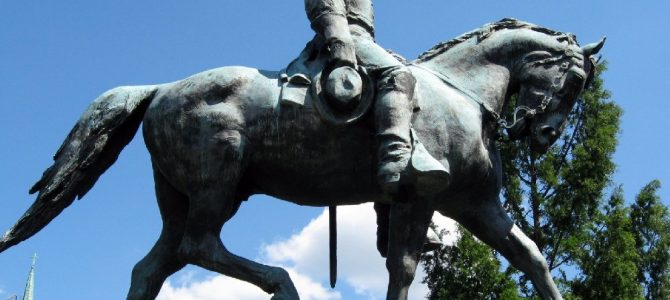Denying History as a Means of Making the Same Mistakes Over Again

The city council of Charlottesville, Virginia, voted earlier this month 3-2 to remove a statue of Confederate Gen. Robert E. Lee from the city foursquare afterward deeming it an offensive symbol of white supremacy.
The council considered 2 options: relocate the statue someplace less prominent, or provide historical context to the monument and use it as a forum for word. They opted for the former. A statue of Stonewall Jackson will be allowed to stay, for now.
After the vote, a GOP candidate for governor visited the park to oppose the decision, and protesters shouted him down with chants of "White supremacy has got to go!" They also "hoist[ed] signs proverb 'Ban Bigots' and 'No tolerance for white supremacy,'" according to the Washington Postal service.
The Lee statue'due south removal is the latest in an ongoing war over Confederate memorials. Perpetual debates remain in New Orleans over a similar Lee statue and in South Carolina over a Jefferson Davis memorial. Last year the National Cathedral in Washington voted to remove Amalgamated symbols from stained glass windows that describe Lee. Moving-picture show critic Lou Lumenick of the New York Mail service even suggested nosotros ought to, in effect, ban "Gone with the Wind."
We Need to Call up, Not Erase, Evil
The Confederacy was a horrible, evil cause. My ancestors risked their lives to fight the Confederacy, and as an officer with the Sons of Marriage Veterans of the Ceremonious War, I spend much of my time remembering the Union heroes opposed to it. We rightly celebrate the Confederacy'southward destruction in the state of war and we understandably abhor its symbols. The Confederate battle flag is a symbol of enemy ability and does not belong over state capitols.
Nonetheless the Confederacy's destructive purpose does not mean that nosotros should snuff out all of its memorialization now. Equally recent as fifty to 60 years ago, the memory of the Confederacy was used to fuel a cultural racism with real political ascendancy. Now Confederate memorialization is by and large a harmless gesture to Southern identity at worst, and historical preservation at best, so the struggle against information technology is generally a series of cheap and self-congratulatory acts.
All Confederate soldiers are dead. They made the ultimate cede for their crusade, and their crusade still failed. It does non have political or moral courage to target a dead Confederate soldier.
At that place is a deeper and more than concerning element: the damnatio memoriae, which means "to condemn the memory." Information technology was the Roman practice of eradicating names and images of hated figures of the past, usually those the ruling class opposed, even after death. It was considered by many to be worse than decease itself. They were scratched out of engravings, their burial statues smashed, their words burnt.
We Don't Desire to Get Where This Ideology Leads
It is an human activity of tribalism and an ideology of extermination, but beyond the insult to history and memory, we must realize information technology started with the words and images, and ofttimes concluded with the associated people. Iconoclasts throughout history always seem to end upward with a body count. Nosotros are a long way from the petty removal of a Robert E. Lee statue to that, but the mindset is the same — and the ideologues who seek the inexpensive opposition to historical figures may, given time and means, eventually talk themselves into it.
History tells united states of america the entrada against Confederate memorials can as well backfire. Aboriginal Egyptians believed that destroying a person's proper name somehow destroyed the person. Pharaoh Horemheb mutilated the cartouches of much of the eighteenth dynasty, including Tutankhamun. In the nineteenth century they were rediscovered, and today Tutankhamun is one of the best-known pharaohs. Removing someone from history creates blank spaces that provoke more questions, ensuring the memories are not forgotten. Like a message in a bottle thrown at sea, history has a way of washing back on shore and grandly revealing what censors have tried to erase.
Ironically, Lee himself frequently opposed edifice Amalgamated memorials because he worried it would acrimony the North and preserve trigger-happy passion for the future. He wanted a speedy reconciliation and saw some Amalgamated memorials as obstacles to it. Many believe the divisions of the Civil State of war remain today and such memorials merely idolatrize the Confederacy's position in that struggle.
Only Lee'southward statue can serve a college purpose. It tin can bring history to life, force us to face up what drove leaders like him to make such wrong decisions, and ask why so many Americans continued to adore them long afterward the war was over. Instead of removing Lee, a society wanting to learn from the successes and failures of history should pay more than attending to him.
Source: https://thefederalist.com/2017/02/20/erasing-history-makes-us-likely-repeat-mistakes/

0 Response to "Denying History as a Means of Making the Same Mistakes Over Again"
Post a Comment